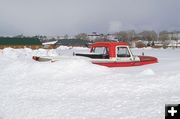Winter weather awareness
A Preparedness Plan can help get you ready for months of snow, freezing cold temperatures, and challenging weather conditions
October 3, 2013
The National Weather Service encourages individuals, families, businesses, schools and others are encouraged to review their winter preparedness plans as winter approaches.
What would you do in a real blizzard? If you are at work, would you be able to drive home? If not, are you prepared to spend the night where you are? If you are on the road, would you be able to make it to a safe shelter. If not, could you survive sub-freezing temperatures and ten foot snow drifts trapping you in or near your vehicle for two days or more?
When a real warning is issued, it will be too late. The National Weather Service suggests these preparedness steps:
* Pack a winter safety kit in your vehicle
* Winterize your automobile
* Remember to stay with your vehicle if you are stranded
* Have your home furnace inspected by a professional
* Arrange for a young relative or neighbor to shovel your driveway and sidewalks
When enjoying the splendor of winter in the Rocky Mountains don't get caught off guard by the elements. Knowledge of the following terms used by the National Weather Service can help you make it through the winter safely and comfortably.
Hazardous Weather Outlook: Hazardous winter weather may develop during the next seven days. This outlook is intended to assist those people that need considerable lead time to prepare for the event, such as ranchers, store owners, outdoor workers and the emergency management community.
Winter Storm Watch: Hazardous winter weather, heavy snow or a blizzard, is possible within the next two days, but the exact timing, location, or occurrence of the storm is still uncertain. A Watch means you should get prepared for a winter storm.
Winter Storm Warning: Hazardous winter weather is imminent, if not already occurring. Travel may become difficult or impossible. You should be ready for a storm by this time. Typically, storm total snowfall of 6 inches or more is expected across the lower elevations or 12 inches or more is anticipated in the mountains.
Blizzard Warning: The most dangerous winter weather will be occuring your area: a combination of winds 35 mph or greater and significant snow and/or blowing snow with visibilities less than 1/4mile for several hours. Blinding snow (near zero visibility), deep snow drifts, and dangerous wind chill will occur. You should seek refuge immediately!
Winter Weather Advisory: Weather conditions are expected to cause significant inconvenience and may be hazardous. However, if caution is exercised, these situations should not become life threatening. The greatest hazard is often to motorists. Typically, storm total snowfall of 3 to 6 inches is expected across the lower elevations or 6 to 12 inches is anticipated in the mountains.
High Wind Watch: Hazardous high wind is possible within the next two days, but the exact timing, location, or occurrence of the high wind is still uncertain. A Watch means you should get prepared for strong wind.
High Wind Warning: Hazardous winds are occurring or will soon occur across a significant area. For elevations below about7500 feet, sustained wind of 40 mph or greater, or gusts to 58 mph or more are occurring or imminent. In higher elevations the criteria is sustained wind of 50 mph or greater, or gusts to at least 75 mph. Travel during high wind events can be dangerous.
One of the best ways to get instant weather forecasts and watch, warning and advisory information is NOAA Weather Radio. These round-the-clock broadcasts can be found on the public service band between 162.400 and 162.550 mhz. Many commercial scanners can be programmed to receive these broadcasts, and several companies sell special radios for this purpose.
These broadcasts can be found throughout the United States. Over 20 NOAA weather radio transmitters are located in or very near Wyoming, at the locations listed below. Reception of the broadcasts is normally limited to within 40 miles of the transmitter.
The Emergency Alert System (EAS) across our nation ensures critical winter weather or severe summer warning messages originating on NOAA Weather Radio are relayed via commercial broadcasters participating in the Emergency Alert System.
Recorded forecast information can also be obtained by telephone from National Weather Service offices throughout the country. The telephone numbers for the offices in and near Wyoming are listed below. For telephone numbers of other offices in the U.S., check directory information under: Department of Commerce National Weather Service.
Forecast information NOAA weather radio
City Telephone number Frequency
Afton, 1-800-211-1448, 162.425 mhz
Billings, 1-406-652-1916, 162.550 mhz
Casper, 1-800-211-1448, 162.400 mhz
Cheyenne, 1-307-635-9901, 162.550 mhz
Cody, 1-800-211-1448, 162.400 mhz
Driggs/Victor, 1-208-233-0137, 162.450 mhz
Dubois, 1-800-211-1448, 162.450 mhz
Evanston, 1-801-524-5133, 162.450 mhz
Gillette, 1-605-341-7531, 162.500 mhz
Glendo, 1-307-635-9901, 162.450 mhz
Grant Village – YNP, 1-800-211-1448, 162.450 mhz
Jackson, 1-800-211-1448, 162.525 mhz
Kaycee, 1-800-211-1448, 162.550 mhz
Kemmerer, 1-800-211-1448, 162.525 mhz
Lander, 1-800-211-1448, 162.475 mhz
Lead, 1-605-341-7531, 162.525 mhz
Mammoth – YNP, 1-800-211-1448, 162.425 mhz
Newcastle, 1-605-341-7531, 162.475 mhz
Pinedale, 1-800-211-1448, 162.500 mhz
Pocatello, 1-208-233-0137, 162.550 mhz
Rawlins, 1-307-635-9901, 162.425 mhz
Rapid City, 1-605-341-7531, 162.550 mhz
Riverton, 1-800-211-1448, 162.475 mhz
Rock Springs, 1-800-211-1448, 162.550 mhz
Salt Lake City, 1-801-524-5133, 162.550 mhz
Sheridan, 1-406-652-1916, 162.475 mhz
Thermopolis, 1-800-211-1448, 162.500 mhz
Worland, 1-800-211-1448, 162.525 mhz
Road information is available from states throughout the central and western U.S. those numbers are:
Wyoming, 1-888-wyo-road / 1-888-996-7623
Colorado, 1-303-639-1111
Kansas, 1-800-585-7623
Nebraska, 1-800-906-9069
South Dakota, 1-866-697-3511
Montana, 1-800-226-7623
Idaho, 1-888-432-7623
Utah, 1-866-511-8824
You can also visit the National Weather Service on the internet and on social media. The Riverton NWS office can be found at:
www.weather.gov/riverton
www.facebook.com/us.nationalweatherservice.riverton.gov
www.twitter.com/nwsriverton
www.youtube.com/nwsriverton
For more winter safety information, contact your local emergency manager, the American Red Cross, or the National Weather Service. Here is the toll free number for the National Weather Service in Riverton: 1-800-211-1448 or go to their website at www.weather.gov/riverton.
|
